Where you see this button
Spider Collector's Journal (21st page: 2011) Copyright © 2011 by Rod Crawford
Here's the 21st page of narratives of fun (and not so fun)
trips to collect spiders for research at the Burke
Museum, often accompanied by capable field volunteer Laurel Ramseyer (Laurel moved East in October; her replacement is Joy Liu). Most also appeared in Scarabogram, newsletter of "Scarabs:
The Bug Society." Dates of field trips head each paragraph. Maps showing
the location of sites within Washington state follow the grid system outlined
in the Washington
Spider Checklist. RETURN
TO INDEX
Where you see this button ![]() in a
field trip account, click it to get a page of collecting site photos!
in a
field trip account, click it to get a page of collecting site photos!
 |
![]() 23 III 2011: This year, Laurel's goal is to visit as many Ponderosa pine sites as possible, to pursue her cone fauna project. There aren't many Ponderosa stands in western Washington, but I thought I had one located: an online book on Puget Sound mountain biking mentions "forests of spruce, Lombardy poplar, cedar, Pondorosa pine, Douglas fir…" on the public trail system of the Pilchuck Tree Farm northeast of Arlington. Laurel was up for the trip despite a mystery electrical problem with her car, and the weather finally turned springlike! We left on schedule and soon arrived at the parking lot (used especially by horse people). The main logging road went through mossy woods, by a little marsh with one frog, and a clearcut and brought us to the bridge across Harvey Creek, washed out a few years ago and still not fixed. My topo map indicated a likely alternate bridge to the south, so we headed for that, passed by a couple of Morgan horses distinctly scared of spider collectors. By this time the day was too warm to wear jackets. The footbridge was indeed there, but on the other side of the creek, the trails got a little bit confusing. However, after a few wrong turns we did reach the spot where I'd guessed the pines might be (an area of glacial sand and gravel with huge potholes). Alas, only Douglas-firs, hemlocks and cedars to be seen: it was the Trail of the Phantom Pine.
23 III 2011: This year, Laurel's goal is to visit as many Ponderosa pine sites as possible, to pursue her cone fauna project. There aren't many Ponderosa stands in western Washington, but I thought I had one located: an online book on Puget Sound mountain biking mentions "forests of spruce, Lombardy poplar, cedar, Pondorosa pine, Douglas fir…" on the public trail system of the Pilchuck Tree Farm northeast of Arlington. Laurel was up for the trip despite a mystery electrical problem with her car, and the weather finally turned springlike! We left on schedule and soon arrived at the parking lot (used especially by horse people). The main logging road went through mossy woods, by a little marsh with one frog, and a clearcut and brought us to the bridge across Harvey Creek, washed out a few years ago and still not fixed. My topo map indicated a likely alternate bridge to the south, so we headed for that, passed by a couple of Morgan horses distinctly scared of spider collectors. By this time the day was too warm to wear jackets. The footbridge was indeed there, but on the other side of the creek, the trails got a little bit confusing. However, after a few wrong turns we did reach the spot where I'd guessed the pines might be (an area of glacial sand and gravel with huge potholes). Alas, only Douglas-firs, hemlocks and cedars to be seen: it was the Trail of the Phantom Pine.
However, now we were there we collected spiders anyway. The first site was all coniferous forest and clearcut, so we beat tree foliage and salal, swept what little grass we could find, and added a couple of species from understory, for 17 species total. Hardly sufficient! So we packed up and headed back to a rich deciduous tree stand spotted while we were "lost," where sifting alder, cottonwood and maple litter added 12 more species; several of these were also in tree moss, which added 3 more. Out of maybe 100 specimens Laurel swept from ferns, only one was a species not taken at the first site; sometimes, the ferns just let you down. An adjacent recent clearcut had a couple of species under wood, plus a nice little marsh with a crew of chorus frogs that stopped singing simultaneously as Laurel approached. Leaving this site with assurance of a decent sample, we stopped at the footbridge across Harvey Creek and added 3 more species. A nice-looking marsh back by the road added only 1 more that was identifiable, but is probably a nice habitat at other seasons. None of the 38 species taken was especially rare, but this tree farm is quite a nice place for a woodland-wetland walk, and also taught us that horse riders ask a lot of questions (well, at least they didn't shoot first)! The car only lost power once on the way home…
 |
![]() 18 V 2011: Well, the month of April was a total washout (coldest in Seattle history, and besides I was moving). Now that it's May, Laurel is preparing to move back to Massachusetts (sob!). But there's still time for a few more field trips to Ponderosa pine country! This time we fulfilled a long-cherished plan to complete a 13-species sample from the Wenas Creek Valley (N edge of Yakima County) taken back in the 1980s. Arrived in the area, we found a gorgeous day with scattered clouds (the prediction had been mostly cloudy)… and a gate across the road up Lady Bug Canyon. Jerry Austin (who managed to get in on a trip with Laurel for the first time) was sent out to see if it was locked; he reported affirmatively, so I decided we might as well collect where we were, with riparian meadows, willow and aspen groves, and sagebrush slopes with lots of Balsamorhiza all around. Jerry climbed over the high gate to collect where the "grass was greener." Spiders were a bit sparse but very diverse. All of us swept riparian grass and herbs for 11 species, including an uncommon Hypsosinga taken by Jerry. I got 3 off sagebrush and 3 more from aspen litter. Active wolf spiders included Pardosa wyuta and juvenile Schizocosa (since matured), and Laurel found a nice Thanatus coloradensis. Jerry and I both turned rocks in separate areas, for 11 species and a scorpion. When almost ready to leave, Laurel discovered the gate wasn't really locked, only latched, so we could have gone up the canyon as originally planned but might not have done as well; as it was, we boosted the original sample to 38 species. But not one "lady bug" did any of us see!
18 V 2011: Well, the month of April was a total washout (coldest in Seattle history, and besides I was moving). Now that it's May, Laurel is preparing to move back to Massachusetts (sob!). But there's still time for a few more field trips to Ponderosa pine country! This time we fulfilled a long-cherished plan to complete a 13-species sample from the Wenas Creek Valley (N edge of Yakima County) taken back in the 1980s. Arrived in the area, we found a gorgeous day with scattered clouds (the prediction had been mostly cloudy)… and a gate across the road up Lady Bug Canyon. Jerry Austin (who managed to get in on a trip with Laurel for the first time) was sent out to see if it was locked; he reported affirmatively, so I decided we might as well collect where we were, with riparian meadows, willow and aspen groves, and sagebrush slopes with lots of Balsamorhiza all around. Jerry climbed over the high gate to collect where the "grass was greener." Spiders were a bit sparse but very diverse. All of us swept riparian grass and herbs for 11 species, including an uncommon Hypsosinga taken by Jerry. I got 3 off sagebrush and 3 more from aspen litter. Active wolf spiders included Pardosa wyuta and juvenile Schizocosa (since matured), and Laurel found a nice Thanatus coloradensis. Jerry and I both turned rocks in separate areas, for 11 species and a scorpion. When almost ready to leave, Laurel discovered the gate wasn't really locked, only latched, so we could have gone up the canyon as originally planned but might not have done as well; as it was, we boosted the original sample to 38 species. But not one "lady bug" did any of us see!
The one problem with the mouth of Lady Bug Canyon was that there were no pine cones for Laurel. So we headed a few more miles up Wenas Valley to get into the pine zone. The nicely pine-studded area we found along Moloy Road had every possible access to habitat plastered with no-trespassing signs, so we were limited to the county road right-of-way, but Laurel had no trouble finding 111 open pine cones to sample, producing 5 identifiable species including a rare, undescribed jumping spider and yet another possibly new Meioneta microspider. Jerry and I swept 8 species along the roadside, there was one mature wolf spider, and I added 4 or 5 from cottonwood litter, making 18 or 19 to supplement a 21-species sample from 2004. On the way home, we capped an enjoyable day with our customary visit to Mountain High Burgers in Easton.
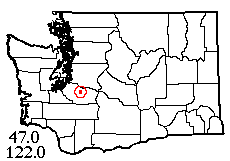 |
![]() 30 V 2011: Even in late May, reconciling field work and suitable weather was still a problem. But Memorial Day Monday looked like a good bet for spider collecting, though mostly cloudy. After a slightly late start, with the newly re-energized Jerry Austin driving and Della Scott providing company and lunch, we headed for the long-planned destination of Fairfax, via Enumclaw, Buckley, Burnett, Wilkeson and Carbonado. Fairfax was an early 20th century coal mining town abandoned shortly after World War I. Now scarcely a brick remains above ground, but the site is marked by lovely riparian meadows, reached by an old road that's now a trail with only a few bad spots. A light intermittent drizzle gave us an inauspicious start. Fortunately I had a spare net, so was able to switch when the first one got soggy from sweeping the roadside verge. That was worth it, producing 9 species that included the rare Porrhomma terrestre and the extremely rare Hypomma marxi (with its amazing male carapace) that I'd never collected before. Farther down the trail, I set up for sifting under a thick hemlock tree to keep dry, and got 5 additional spider species (3 from moss and 2 from litter), not very rich but worth trying. By this time the clouds had thinned and the rest of the day promised to be drier.
30 V 2011: Even in late May, reconciling field work and suitable weather was still a problem. But Memorial Day Monday looked like a good bet for spider collecting, though mostly cloudy. After a slightly late start, with the newly re-energized Jerry Austin driving and Della Scott providing company and lunch, we headed for the long-planned destination of Fairfax, via Enumclaw, Buckley, Burnett, Wilkeson and Carbonado. Fairfax was an early 20th century coal mining town abandoned shortly after World War I. Now scarcely a brick remains above ground, but the site is marked by lovely riparian meadows, reached by an old road that's now a trail with only a few bad spots. A light intermittent drizzle gave us an inauspicious start. Fortunately I had a spare net, so was able to switch when the first one got soggy from sweeping the roadside verge. That was worth it, producing 9 species that included the rare Porrhomma terrestre and the extremely rare Hypomma marxi (with its amazing male carapace) that I'd never collected before. Farther down the trail, I set up for sifting under a thick hemlock tree to keep dry, and got 5 additional spider species (3 from moss and 2 from litter), not very rich but worth trying. By this time the clouds had thinned and the rest of the day promised to be drier.
After a lunch break, I continued down the road to the main townsite and its meadows (still too moist to sweep). A solitary spruce tree had several species not found on the scattered hemlocks beaten earlier. Lots of wolf spiders ran around when a little filtered sunlight appeared, and I caught three Pardosa species. I knew the banks of the Carbon River must be close by, but a route there took some finding. Under the riverbank cobbles I found just one spider, but it was all worth doing because that one was another true rarity, Cybaeopsis spenceri, found in Washington just once before. I sifted meadow litter for a while and added 5 more species, then noticed it was a little past the time I'd told Della I'd be back at the car, so started back up to the road. I stopped at a rocky ravine to turn rocks, adding another 4 species, exceptional for western Washington rock fauna; while I was doing so Jerry caught up with me (he and I had been wandering around the townsite for hours without ever crossing paths). He'd been mostly sweeping (with a less water-absorbent net) and added another 6 or 7 species. I even found an additional Xysticus under old burlap bags. In all we got 36 species, making 38 with an old sample from the 1960s. We had fun too, in this beautiful, secluded spot! The only flies in the ointment were some stealthy no-see-ums…
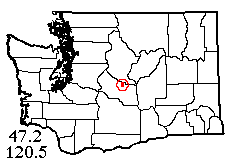 |
![]() 4 VI 2011: The Scarabs joint field trip (with the butterfly association and native plant society) to Reecer Creek north of Ellensburg was well-attended and very successful, with perhaps 30 butterfly species sighted. Laurel and I joined the group for a while and then headed on up Table Mountain to try to upgrade an inadequate spider sample taken in 2008 on the potentially very interesting high plateau. Snow on the road blocked our route about a half mile into the grid area at 5400í elevation, near one of our less successful sample sites of the previous trip. A few lycosids, none mature, were active in areas wet with snowmelt. Conifer foliage was fairly productive and (though not obvious at the time), provided three species not taken there before. Meanwhile, Laurel was trying her hardest to get some spiders from the small lodgepole pine cones, only a few of which were open; the few species she got didnít include any cone specialists. I was thinking that under-stone spider fauna should be good here, if we could find any. Across the road was a large clearing completely covered with stones, some of them loose enough to lift, but the pickings were very sparse at first. However, I finally found "pay dirt" in the shade of a small tree group, where the rocks produced Cicurina, Antrodiaetus, and both sexes of a possibly new antlike Scotinella species. Laurel added two linyphiid species from other rocks. Almost as an afterthought, I decided to spend a little time sifting fir litter from a bigger tree clump downslope from the rocks. Bingo! In addition to Cryphoeca, Tapinocyba, Lepthyphantes and two Tachygyna species, I got the rare Walckenaeria helenae and the mega-rare Coreorgonal bicornis (see album for bizarre carapace), a first for me and the second Washington record! The upshot: 28-29 spider species now known from Table Mountain.
4 VI 2011: The Scarabs joint field trip (with the butterfly association and native plant society) to Reecer Creek north of Ellensburg was well-attended and very successful, with perhaps 30 butterfly species sighted. Laurel and I joined the group for a while and then headed on up Table Mountain to try to upgrade an inadequate spider sample taken in 2008 on the potentially very interesting high plateau. Snow on the road blocked our route about a half mile into the grid area at 5400í elevation, near one of our less successful sample sites of the previous trip. A few lycosids, none mature, were active in areas wet with snowmelt. Conifer foliage was fairly productive and (though not obvious at the time), provided three species not taken there before. Meanwhile, Laurel was trying her hardest to get some spiders from the small lodgepole pine cones, only a few of which were open; the few species she got didnít include any cone specialists. I was thinking that under-stone spider fauna should be good here, if we could find any. Across the road was a large clearing completely covered with stones, some of them loose enough to lift, but the pickings were very sparse at first. However, I finally found "pay dirt" in the shade of a small tree group, where the rocks produced Cicurina, Antrodiaetus, and both sexes of a possibly new antlike Scotinella species. Laurel added two linyphiid species from other rocks. Almost as an afterthought, I decided to spend a little time sifting fir litter from a bigger tree clump downslope from the rocks. Bingo! In addition to Cryphoeca, Tapinocyba, Lepthyphantes and two Tachygyna species, I got the rare Walckenaeria helenae and the mega-rare Coreorgonal bicornis (see album for bizarre carapace), a first for me and the second Washington record! The upshot: 28-29 spider species now known from Table Mountain.
Still seeking some good pine cone fauna, we made one stop on the way back down the mountain at a spot with some big ponderosa trees. Most cones were old and weathered, and produced vanishingly few spiders although those few were good, including two Dictyna species and Anyphaena pacifica. At the cost of missing the closing time of our favorite burger joint, we decided to try one last site on the way home, near Teanaway Campground near the confluence of the North, Middle and West forks of the Teanaway River. Laurel was very pleased with the pine cones and their fauna here (though not very diverse) and I got 6 species from the vegetation while she tapped her 103 cones. Still more to do there, and a nice place to do it in.
 |
![]() 12 VI 2011: After a few delays, another trip with the Austin vehicle got under way on Sunday morning. Participating were not only Jerry but his brother Ron and nephew Liam. I'd intended to visit Hamilton Bog, a little-known but potentially very good Sphagnum habitat in the Skagit River valley. Unfortunately, the access route we tried was blocked by private roads and gates, and we missed the turn for another possible access. Fortunately I had backup plans. I'd long intended to collect subalpine fauna in the saddle between Jackman Ridge and Sauk Mountain. Snow prevented our ascending all the way to the saddle, but we were able to collect in well-developed western hemlock forest at 3050' elevation at the end of Jackman Ridge. Belts of cottonwood extending through the conifers provided some productive leaf litter, with 6 spider species collected. Meanwhile, Jerry and Liam found 2 additional larger species under log bark. All collectors beat hemlock foliage for 10 identifiable species. I had high hopes for the spiders sifted from moss and tapped from dead wood, but alas, they only duplicated the litter sample. Ron spent the time testing a new digital video setup; some stills may appear in the Album at a future date. We left this site with only 18 species.
12 VI 2011: After a few delays, another trip with the Austin vehicle got under way on Sunday morning. Participating were not only Jerry but his brother Ron and nephew Liam. I'd intended to visit Hamilton Bog, a little-known but potentially very good Sphagnum habitat in the Skagit River valley. Unfortunately, the access route we tried was blocked by private roads and gates, and we missed the turn for another possible access. Fortunately I had backup plans. I'd long intended to collect subalpine fauna in the saddle between Jackman Ridge and Sauk Mountain. Snow prevented our ascending all the way to the saddle, but we were able to collect in well-developed western hemlock forest at 3050' elevation at the end of Jackman Ridge. Belts of cottonwood extending through the conifers provided some productive leaf litter, with 6 spider species collected. Meanwhile, Jerry and Liam found 2 additional larger species under log bark. All collectors beat hemlock foliage for 10 identifiable species. I had high hopes for the spiders sifted from moss and tapped from dead wood, but alas, they only duplicated the litter sample. Ron spent the time testing a new digital video setup; some stills may appear in the Album at a future date. We left this site with only 18 species.
Back down on Highway 20, we made a planned second stop at a public access point along the Skagit River, much lower in elevation but not far horizontally from our mountain site. Summer fauna was beginning here and we got 11 species mostly from the lush vegetation, 5 of them introduced in contrast to the all-native spider fauna of the higher site. Two native crab spiders were even rather interesting records. Our total was 28 species from the area, making a respectable total of 30 with some old records from the 1970s. For our post-trip meal we tried out Cascade Burgers, a pleasantly retro place in Concrete, and found everything tasty enough.
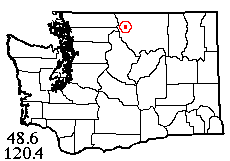 |
![]() 21-22 VI 2011, The Okanogan Highlands Mini-Expedition: (See Laurel's account of this trip here). Last July, Laurel visited the North Cascades Base Camp near Mazama (Okanogan County) with relatives, and got only 6 identifiable species! This year Laurel, Jerry and I expected to do much better. On our way over the North Cascades Highway, we were entertained by a bizarre rainbow-colored cloud in the Marblemount area (see album). We arrived at the "base camp," owned by Kim and Steve Bondi, on schedule around 2 pm. Laurel stayed near the buildings to work on her pine cone project while Jerry wandered off into the woods and I accompanied Steve and the kids to a birch grove halfway to the Methow River on this lovely 21-acre property. The birch litter (sifted with kid help) produced only 4 species but they were good ones, including Hahnia arizonica (1 prior Washington record). I did much better while sweeping an adjacent clearing, with 4 crab spider & 2 jumping spider species, 2 dictynids, Pityohyphantes minidoka, Cyclosa conica, a colorful Theridion and even a Poecilochroa. Fir foliage added 2 more, and I got another Dictyna on sand bars by the river. Meanwhile, Laural industriously beat 173 pine cones getting 5 spider species (2 of which she'd got last year). Jerry came back with 11 species from vegetation including one I hadn't got, and a nice Callobius from under bark. In 2.5 hours we'd boosted records from the site to 28 species.
21-22 VI 2011, The Okanogan Highlands Mini-Expedition: (See Laurel's account of this trip here). Last July, Laurel visited the North Cascades Base Camp near Mazama (Okanogan County) with relatives, and got only 6 identifiable species! This year Laurel, Jerry and I expected to do much better. On our way over the North Cascades Highway, we were entertained by a bizarre rainbow-colored cloud in the Marblemount area (see album). We arrived at the "base camp," owned by Kim and Steve Bondi, on schedule around 2 pm. Laurel stayed near the buildings to work on her pine cone project while Jerry wandered off into the woods and I accompanied Steve and the kids to a birch grove halfway to the Methow River on this lovely 21-acre property. The birch litter (sifted with kid help) produced only 4 species but they were good ones, including Hahnia arizonica (1 prior Washington record). I did much better while sweeping an adjacent clearing, with 4 crab spider & 2 jumping spider species, 2 dictynids, Pityohyphantes minidoka, Cyclosa conica, a colorful Theridion and even a Poecilochroa. Fir foliage added 2 more, and I got another Dictyna on sand bars by the river. Meanwhile, Laural industriously beat 173 pine cones getting 5 spider species (2 of which she'd got last year). Jerry came back with 11 species from vegetation including one I hadn't got, and a nice Callobius from under bark. In 2.5 hours we'd boosted records from the site to 28 species.
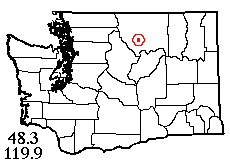 |
![]() Way, way back in 1981 I'd been in the Methow Valley with a lepidopterist, and as usual got a series of inadequate spider samples during short butterfly stops. To supplement a 13-species sample from Finley Canyon (including some real rarities from the shaded talus habitat) we stopped 3 miles north at Jack Creek along highway 20. I worked on riparian habitats, Laurel sampled cones, and Jerry was soon over the hills and far away. The understory produced little but I got a number of species from roadside verge and fir foliage, including a male of the rare mysmenid, Trogloneta. Laurel also got one from cones, plus an unusually large wolf spider that must have found it a tight squeeze between the cone scales. Jerry found little on hilltop flora but got 4 excellent records from under stones, though it was hard to track him down when we were ready to leave! In 2 early evening hours of the long first day of summer, we boosted this sample to 30 species.
Way, way back in 1981 I'd been in the Methow Valley with a lepidopterist, and as usual got a series of inadequate spider samples during short butterfly stops. To supplement a 13-species sample from Finley Canyon (including some real rarities from the shaded talus habitat) we stopped 3 miles north at Jack Creek along highway 20. I worked on riparian habitats, Laurel sampled cones, and Jerry was soon over the hills and far away. The understory produced little but I got a number of species from roadside verge and fir foliage, including a male of the rare mysmenid, Trogloneta. Laurel also got one from cones, plus an unusually large wolf spider that must have found it a tight squeeze between the cone scales. Jerry found little on hilltop flora but got 4 excellent records from under stones, though it was hard to track him down when we were ready to leave! In 2 early evening hours of the long first day of summer, we boosted this sample to 30 species.
 |
![]() Now for our intended campsite on the Sanpoil River in Ferry County to the east. Make that far east. By the time we unloaded camping gear it was barely light enough to do so. We erected tents by flashlight, Jerry having more success at it than I with his simpler tent. Mine looked like How Not to Erect a Tent, but it covered my sleeping bag and I got enough sleep to get by before rising around 5 AM to pack up and start collecting at the trip's main site. Cottonwood litter by Thirteenmile Creek gave me 8 species, with 3 more from sifting moss on riverbank rocks. The fir foliage didn't seem too productive at first, but with persistence and some better trees I got fully 13 species. A female Phidippus was active on my pack; Jerry got a male under stones, plus a rare undescribed Apostenus. Various other habitats each produced a few, while we waited for dew to evaporate from a grassy meadow. Meanwhile, Laurel arrived from her motel (she'd made a separate cone collection across the street from the Ferry County Hospital, including the first male of Neon sp. #1) and climbed high on the canyon side to beat her hundred pine cones (only 2 species identifiable here). Finally the meadow dried enough to produce its own 13 species (Jerry got more of those than I did). Starting from scratch, the three of us had collected 42 species from this site – highly scenic too, and with few mosquitos!
Now for our intended campsite on the Sanpoil River in Ferry County to the east. Make that far east. By the time we unloaded camping gear it was barely light enough to do so. We erected tents by flashlight, Jerry having more success at it than I with his simpler tent. Mine looked like How Not to Erect a Tent, but it covered my sleeping bag and I got enough sleep to get by before rising around 5 AM to pack up and start collecting at the trip's main site. Cottonwood litter by Thirteenmile Creek gave me 8 species, with 3 more from sifting moss on riverbank rocks. The fir foliage didn't seem too productive at first, but with persistence and some better trees I got fully 13 species. A female Phidippus was active on my pack; Jerry got a male under stones, plus a rare undescribed Apostenus. Various other habitats each produced a few, while we waited for dew to evaporate from a grassy meadow. Meanwhile, Laurel arrived from her motel (she'd made a separate cone collection across the street from the Ferry County Hospital, including the first male of Neon sp. #1) and climbed high on the canyon side to beat her hundred pine cones (only 2 species identifiable here). Finally the meadow dried enough to produce its own 13 species (Jerry got more of those than I did). Starting from scratch, the three of us had collected 42 species from this site – highly scenic too, and with few mosquitos!
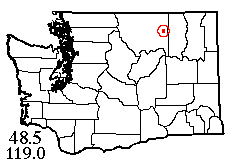 |
![]() Heading back west in the middle of June 22, I'd planned to stop in the Aeneas Valley (eastern Okanogan County). Public land was hard to find here but we located the one possible parcel and found it very productive. In a rather short time, we got 27 species from various habitats beside Aeneas Valley Road. While I took 10 species from Douglas-fir and 4 from understory grass, Jerry found a Zelotes fratris under a paper bag and 5 additional species under stones, including a Trochosa with eggs. Laurel got one of her most diverse pine cone samples here with 5 identifiable and a few unidentifiable species, plus a large female millipede. I found an access point to the marsh below the road and quickly added 5 more species, including a female Pachygnatha that just might be the elusive P. xanthostoma. 'Twas a lucky site for us!
Heading back west in the middle of June 22, I'd planned to stop in the Aeneas Valley (eastern Okanogan County). Public land was hard to find here but we located the one possible parcel and found it very productive. In a rather short time, we got 27 species from various habitats beside Aeneas Valley Road. While I took 10 species from Douglas-fir and 4 from understory grass, Jerry found a Zelotes fratris under a paper bag and 5 additional species under stones, including a Trochosa with eggs. Laurel got one of her most diverse pine cone samples here with 5 identifiable and a few unidentifiable species, plus a large female millipede. I found an access point to the marsh below the road and quickly added 5 more species, including a female Pachygnatha that just might be the elusive P. xanthostoma. 'Twas a lucky site for us!
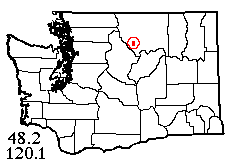 |
![]() Down in the sagebrush country of the Okanogan Valley, Laurel learned by cell phone that she needed to be home that night. We made a brief stop near Crumbacker Lake to find out what lived in pine cones in sagebrush habitat. The results weren't too different from those on the Methow River; I took a little siesta after catching one adult Schizocosa mccooki, while Jerry fruitlessly pursued a large population of other wolf spiders that I'd warned him were immature.
Down in the sagebrush country of the Okanogan Valley, Laurel learned by cell phone that she needed to be home that night. We made a brief stop near Crumbacker Lake to find out what lived in pine cones in sagebrush habitat. The results weren't too different from those on the Methow River; I took a little siesta after catching one adult Schizocosa mccooki, while Jerry fruitlessly pursued a large population of other wolf spiders that I'd warned him were immature.
We had time for one more stop, and I had another of those old 14 species samples to supplement, from the Libby Creek valley (a Methow River tributary). Just because we liked the name, we chose our site in a side canyon called Hornet Draw. It was a mesic area where the pines were being outcompeted by Douglas-fir, and Laurel only sampled 50 cones, but they produced 4 identifiable species. I got Callobius from logs and stumps, and Jerry and I added enough others from vegetation to bring the sample to 26 species. Jerry must have had to move fast to evade the more numerous mosquitos here; Laurel had to go track him down before we could leave. Then back over the North Cascades through a very scenic dusk, finally reaching Seattle around midnight with 5 excellent site samples in my hatfull of vials!
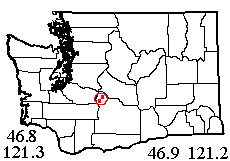 |
![]() 3 VII 2011: A few years ago, Fred Austin, visiting a cabin on Bumping Lake, brought back 7 species. To supplement this, I picked some potential meadow and wetland habitats on the southeast side of the lake. The road to most of these happened to be washed out by a flood on Deep Creek, so (after collecting 2 species among the road repair outfit and seeing a huge bull elk cross the road in front of me) we set off by compass across country. Our goal: an unnamed meadow on an unnamed creek, unsuspected by the holiday-makers raising dust on the roads and spray on the lake. Laurel found the forest very satisfactory; too high in the mountains for Ponderosa, it contained a good scattering of white pines, whose cones are even bigger. We reached the meadow; at its edge it looked more like a marsh, but a few log-bridges brought me across the wettest parts into a grassy expanse with scattered trees, seemingly untrodden by any but deer and bears. I swept grass in splendid solitude for some time, but the meadow spiders werenít very diverse (6 species). Pardosa metlakatla was active on little dry islands. I got a somewhat better sample from foliage of isolated conifers within the wetland; while Laurel got an almost entirely different assemblage from the same habitat back in the forest. She got a nice mature Novalena under bark, but the fauna in the big pine cones was rather sparse. We successfully found each other and got back to the road with merely 20 species, making 26 with the prior records.
3 VII 2011: A few years ago, Fred Austin, visiting a cabin on Bumping Lake, brought back 7 species. To supplement this, I picked some potential meadow and wetland habitats on the southeast side of the lake. The road to most of these happened to be washed out by a flood on Deep Creek, so (after collecting 2 species among the road repair outfit and seeing a huge bull elk cross the road in front of me) we set off by compass across country. Our goal: an unnamed meadow on an unnamed creek, unsuspected by the holiday-makers raising dust on the roads and spray on the lake. Laurel found the forest very satisfactory; too high in the mountains for Ponderosa, it contained a good scattering of white pines, whose cones are even bigger. We reached the meadow; at its edge it looked more like a marsh, but a few log-bridges brought me across the wettest parts into a grassy expanse with scattered trees, seemingly untrodden by any but deer and bears. I swept grass in splendid solitude for some time, but the meadow spiders werenít very diverse (6 species). Pardosa metlakatla was active on little dry islands. I got a somewhat better sample from foliage of isolated conifers within the wetland; while Laurel got an almost entirely different assemblage from the same habitat back in the forest. She got a nice mature Novalena under bark, but the fauna in the big pine cones was rather sparse. We successfully found each other and got back to the road with merely 20 species, making 26 with the prior records.
![]() Having a few hours of daylight left, we stopped farther down the Bumping River at Cougar Flat Campground (which was closed) so Laurel could get a Ponderosa pine cone sample as well. The reason for the closure soon became apparent – a flood and storm had practically destroyed the place, dumping piles of sand and rocks on the roads and sending trees down to smash picnic tables! Of course, all leaf litter was washed away, but the spider fauna was rich in the vanilla-leaf forest understory, 8 species including the very rare Theridion michelbacheri. I took most of the same species and a few more from Abies grandis foliage. Laurel and I checked out two surviving camp outhouses for 3 species. Feeling short of records, I tried sifting conifer litter closer to the highway, getting just one species for much effort. Fortunately the big cone sample (240 cones!) saved the day, bringing the site to 21 species. Not extremely rich collecting, but a useful day with good records resulting.
Having a few hours of daylight left, we stopped farther down the Bumping River at Cougar Flat Campground (which was closed) so Laurel could get a Ponderosa pine cone sample as well. The reason for the closure soon became apparent – a flood and storm had practically destroyed the place, dumping piles of sand and rocks on the roads and sending trees down to smash picnic tables! Of course, all leaf litter was washed away, but the spider fauna was rich in the vanilla-leaf forest understory, 8 species including the very rare Theridion michelbacheri. I took most of the same species and a few more from Abies grandis foliage. Laurel and I checked out two surviving camp outhouses for 3 species. Feeling short of records, I tried sifting conifer litter closer to the highway, getting just one species for much effort. Fortunately the big cone sample (240 cones!) saved the day, bringing the site to 21 species. Not extremely rich collecting, but a useful day with good records resulting.
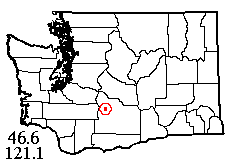 |
![]() 10 VII 2011: Interested in getting farther south than hitherto in the Ponderosa pine belt, we went down the east side of Mt. Rainier to intersect the White Pass highway (72 miles shorter than going via I-5), and over the pass to Rimrock in far northwest Yakima County. The goal was Thunder Lake, easily found (near smaller Lightning Lake) and very attractive, if it hadnít been for the litter (not the kind you sift) left by previous visitors. The folks before us also left a smouldering campfire, which Laurel drowned. The small lake has risen somewhat and drowned a few pine trees, but there were plenty more, plus a sedge-rush-grass marsh, mixed forest, and an old clearcut that had grown into a shrubland with much Ceanothus in bloom and small trees, flowers, and grassy swales. Despite the many attractive habitats, it was rather hard work getting a good spider sample here, but we managed 28 species in the end. Sweeping around the lake only produced 6, but I got 13 from ever-reliable conifer foliage. Turning stones, sifting fir litter and tapping dead wood brought me one species each. Fortunately, Laurelís pine cone samples were rather rich here and added quite a few species including an unidentified Dictyna, a nice adult Poecilochroa columbiana, both sexes of Habronattus sansoni and best of all, undescribed Dipoena sp. #1 (only taken once before). A short stop at some Forest Service cabins down the road added just 4 more species from around the buildings.
10 VII 2011: Interested in getting farther south than hitherto in the Ponderosa pine belt, we went down the east side of Mt. Rainier to intersect the White Pass highway (72 miles shorter than going via I-5), and over the pass to Rimrock in far northwest Yakima County. The goal was Thunder Lake, easily found (near smaller Lightning Lake) and very attractive, if it hadnít been for the litter (not the kind you sift) left by previous visitors. The folks before us also left a smouldering campfire, which Laurel drowned. The small lake has risen somewhat and drowned a few pine trees, but there were plenty more, plus a sedge-rush-grass marsh, mixed forest, and an old clearcut that had grown into a shrubland with much Ceanothus in bloom and small trees, flowers, and grassy swales. Despite the many attractive habitats, it was rather hard work getting a good spider sample here, but we managed 28 species in the end. Sweeping around the lake only produced 6, but I got 13 from ever-reliable conifer foliage. Turning stones, sifting fir litter and tapping dead wood brought me one species each. Fortunately, Laurelís pine cone samples were rather rich here and added quite a few species including an unidentified Dictyna, a nice adult Poecilochroa columbiana, both sexes of Habronattus sansoni and best of all, undescribed Dipoena sp. #1 (only taken once before). A short stop at some Forest Service cabins down the road added just 4 more species from around the buildings.
It was still early enough to make a short visit to another area in order. Farther down U.S.12, another side road led to the turnoff for Fish Flats, not really in driveable condition but not a long walk. The "Flats", really a large meadow, was really beautiful with varied grassy areas, wet spots with yellow monkeyflowers, and groves of huge old ponderosa pines, many with uncharacteristic branching forms. Should be great pine cone fauna here, no? 50 cones brought Laurel just one spider! Possibly the habitat was too disturbed by the numerous elk that also use the meadow (their hooves had churned up muddy parts of the road like a drove of cattle). Sweeping only got me 3 species here. Just a little head start for a better sample elsewhere in the vicinity at a later date. Laurel was now tired enough to want to take the long way back so as to avoid mountain driving. Hard for a non-driver to understand wanting to spend almost 2 hours more on the road, but I had no reason to object. At least we got a decent sample from Thunder Lake, filling in quite a blank on the coverage map.
 |
![]() 17 VII 2011: Laurel had time for just one more trip before leaving for Massachusetts. Knowing her penchant for interesting place names, I planned a trip to Salmon La Sac (not really a town, just a Forest Service facility and some vacation cabins), way up the Cle Elum River from Roslyn and Ronald. The weather forecast was iffy, but this being our last chance, we went for it anyway. On approaching our goal, we found we had just left the Ponderosa pine zone and were in more mesic forest, mostly of firs and hemlocks. However, a side road that I'd thought was promising brought us to a spot with several white pine trees, plus a little glade with a bigleaf maple in it, and a blocked side road covered with rocks just the right size for turning over. Laurel worked on the white pine cones and got 9 species from 55 of them including uncommon Agroeca ornata. After sweeping only 3 species from grass, I found the maple litter had a reasonable number of spiders, mostly juvenile as it turned out but including Zora hespera, lots of Zanomys aquilonia, and a male Dictyna I can't yet place. I turned stones while Laurel beat Ceanothus for 3 more species each.
17 VII 2011: Laurel had time for just one more trip before leaving for Massachusetts. Knowing her penchant for interesting place names, I planned a trip to Salmon La Sac (not really a town, just a Forest Service facility and some vacation cabins), way up the Cle Elum River from Roslyn and Ronald. The weather forecast was iffy, but this being our last chance, we went for it anyway. On approaching our goal, we found we had just left the Ponderosa pine zone and were in more mesic forest, mostly of firs and hemlocks. However, a side road that I'd thought was promising brought us to a spot with several white pine trees, plus a little glade with a bigleaf maple in it, and a blocked side road covered with rocks just the right size for turning over. Laurel worked on the white pine cones and got 9 species from 55 of them including uncommon Agroeca ornata. After sweeping only 3 species from grass, I found the maple litter had a reasonable number of spiders, mostly juvenile as it turned out but including Zora hespera, lots of Zanomys aquilonia, and a male Dictyna I can't yet place. I turned stones while Laurel beat Ceanothus for 3 more species each.
Our next stop (a different habitat to supplement the first site) was at a gravel pit a little to the north. Overlooking it was one white pine tree! The tree being fairly big, Laurel found 40 cones under it with plenty of spiders, several of them different from the other nearby site. I beat conifer foliage for 10 species and several of the introduced harvestman Phalangium opilio, then found a Steatoda albomaculata under bark and a Pimoa curvata among some old lumber. In all, we got 28 spider species from the area just south of Salmon La Sac, plus some very nice scenery.
We'd hoped to get another full sample at Tucquala Lake, 10 miles farther into the hinterland. The road immediately deteriorated with more than enough potholes to arouse the ire of any city dweller. But eventually we were very nearly to the lake, when we passed a sign "Water on Road" – yes indeed, a branch of Scatter Creek that was practically a young river was on top of the roadway, barring further progress. Having driven so far, we collected where we were, getting 9 species by the time it started to rain! Oh well, we'd done well enough in the first area. On the way home, we stopped at Wish-Poosh Campground so Laurel could sample some Ponderosa cones. These, too, were rich in spiders, 10 species in the first 50 cones including the same unfamiliar Dictyna I'd taken from the maple litter. Despite rain and the aquatic roadblock, not a bad trip at all.
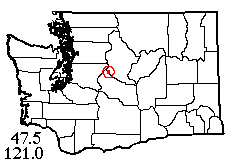 |
![]() 24 VII 2011: Markku Savela was back in town, interested in field trips, and had rented a Jeep SUV. So my first thought was, why not try fording that stream and go back to Tucquala Lake on a nice day? It worked very well! We sailed over the stream and parked by one of the most gorgeous lakes I've ever seen (see album), with sun-drenched meadows overflowing with diverse flowers. There were several butterfly species for Markku to photograph also. My first concern was to sweep the meadows (including grass, herb, rush and shrub areas) which gave me thirteen species in short order. Hemlock and fir foliage added 4 more. Higher in the woods, in addition to more mosquitos, there were patches of under-stone habitat that gave me Pardosa mackenziana; Zelotes fratris (one with a white egg sac instead of the usual pink); Orodrassus canadensis in a large, perfectly round egg retreat; rare wolf spider Tarentula aculeata; and a completely new Callobius species! The forest understory produced little, so I rounded out the sample by sifting conifer litter, not as productive as it is in old growth but adding 2 more species for a total of 24. A short day but a very worthwhile one.
24 VII 2011: Markku Savela was back in town, interested in field trips, and had rented a Jeep SUV. So my first thought was, why not try fording that stream and go back to Tucquala Lake on a nice day? It worked very well! We sailed over the stream and parked by one of the most gorgeous lakes I've ever seen (see album), with sun-drenched meadows overflowing with diverse flowers. There were several butterfly species for Markku to photograph also. My first concern was to sweep the meadows (including grass, herb, rush and shrub areas) which gave me thirteen species in short order. Hemlock and fir foliage added 4 more. Higher in the woods, in addition to more mosquitos, there were patches of under-stone habitat that gave me Pardosa mackenziana; Zelotes fratris (one with a white egg sac instead of the usual pink); Orodrassus canadensis in a large, perfectly round egg retreat; rare wolf spider Tarentula aculeata; and a completely new Callobius species! The forest understory produced little, so I rounded out the sample by sifting conifer litter, not as productive as it is in old growth but adding 2 more species for a total of 24. A short day but a very worthwhile one.
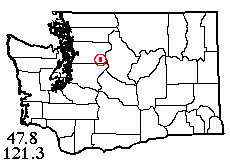 |
![]() 29 VII 2011: My friend Della and I had access to a borrowed car for 3 weeks, and I planned a trip to the vicinity of a little-known "hot" (really just lukewarm) spring on the North Fork Skykomish River to combine her hot-spring interest with filling in a gap in the collecting map. I didn't realize she wasn't really interested in seeing a spring she couldn't soak in, so we never actually went near it. Instead we stopped at Jack Pass (2590'), some 20 miles north of the Stevens Pass Highway, where 5 logging roads come together. Parking a ways up one of the less-frequented ones, we swept the roadside verge (getting 7 species all told after much hard work). I tried the forest understory but it added nothing new that was mature. There was some quasi-old growth in the vicinity, and I found an accessible grove for sifting conifer litter. The grove was rather open with much sunlight hitting the ground, so the litter was intertwined with roots and moss, but the few good pockets I found still produced 5 species and a good ethopolid centipede. Fir foliage only added 2 that I hadn't already swept. No mosquitos at the pass but plenty of rather pretty deer flies, fortunately slow biters.
29 VII 2011: My friend Della and I had access to a borrowed car for 3 weeks, and I planned a trip to the vicinity of a little-known "hot" (really just lukewarm) spring on the North Fork Skykomish River to combine her hot-spring interest with filling in a gap in the collecting map. I didn't realize she wasn't really interested in seeing a spring she couldn't soak in, so we never actually went near it. Instead we stopped at Jack Pass (2590'), some 20 miles north of the Stevens Pass Highway, where 5 logging roads come together. Parking a ways up one of the less-frequented ones, we swept the roadside verge (getting 7 species all told after much hard work). I tried the forest understory but it added nothing new that was mature. There was some quasi-old growth in the vicinity, and I found an accessible grove for sifting conifer litter. The grove was rather open with much sunlight hitting the ground, so the litter was intertwined with roots and moss, but the few good pockets I found still produced 5 species and a good ethopolid centipede. Fir foliage only added 2 that I hadn't already swept. No mosquitos at the pass but plenty of rather pretty deer flies, fortunately slow biters.
Time to move on to a site we hoped would add different species, in the floodplain down below along the North Fork. Here there was maple litter to sift (added 2 species), moss on the trees and rocks (3 more), rich-looking understory (1 more) and finally a nice rockpile along the road (2 more). I just made it with 21 species! Down in the maple forest there were indeed mosquitos, and they were hungry! The most interesting thing about this trip was what we didn't get. Though the area was rather remote, it was still pretty typical western Washington habitats. But no philodromine crab spiders (except P. rufus), no Enoplognatha ovata (and this is their prime season), no Metellina whatever (and one usually gets at least juveniles of those at any season), and other notable absences. Odd. Maybe someday such things will be more explainable. We dined well at Zeke's outside Gold Bar.
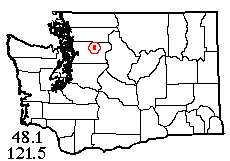 |
![]() 3 VIII 2011: The second trip I'd planned with Della and the borrowed car was to Kelcema Lake, at the end of a short trail from Deer Creek road off the Mountain Loop Highway. At 3200 feet elevation, after the very late spring and high snowpack I hoped we could get a good sample here. Just arriving at the trailhead (after a late start), who should pull up beside us but Markku Savela and his toddler son Tristan! (Not totally a coincidence – I'd given him the coordinates of our destination). I headed straight for the lake, followed by the others at their own speeds. A number of various-sized snow patches remained in the forest, which disappointlgly was not old growth (perhaps due to a past forest fire). At the very pretty lake, there was no riparian meadow at all, but collecting started well with 5 species from huckleberry shrubs. Much conifer beating eventually brought me 4 more (plus 4 of the same species taken in shrubs), but lacking some that I really expected to find. I got one mature wolf spider, and a little patch of Sphagnum moss at the water's edge produced Eularia arctoa. I had really counted on making up any shortage of diversity from conifer litter in the forest, but was out of luck – I tried in several places but in this younger forest there were few litter spiders and only one identifiable. Dead wood produced nothing here. Almost back to the car, I stopped at a little meadow I'd given barely a glance on the way in. It turned out to be a Sphagnum bog with very diverse flora. I took a sweep sample, adding 3 species, but didn't stop to sift the moss because I'd planned to visit another nearby site before dark.
3 VIII 2011: The second trip I'd planned with Della and the borrowed car was to Kelcema Lake, at the end of a short trail from Deer Creek road off the Mountain Loop Highway. At 3200 feet elevation, after the very late spring and high snowpack I hoped we could get a good sample here. Just arriving at the trailhead (after a late start), who should pull up beside us but Markku Savela and his toddler son Tristan! (Not totally a coincidence – I'd given him the coordinates of our destination). I headed straight for the lake, followed by the others at their own speeds. A number of various-sized snow patches remained in the forest, which disappointlgly was not old growth (perhaps due to a past forest fire). At the very pretty lake, there was no riparian meadow at all, but collecting started well with 5 species from huckleberry shrubs. Much conifer beating eventually brought me 4 more (plus 4 of the same species taken in shrubs), but lacking some that I really expected to find. I got one mature wolf spider, and a little patch of Sphagnum moss at the water's edge produced Eularia arctoa. I had really counted on making up any shortage of diversity from conifer litter in the forest, but was out of luck – I tried in several places but in this younger forest there were few litter spiders and only one identifiable. Dead wood produced nothing here. Almost back to the car, I stopped at a little meadow I'd given barely a glance on the way in. It turned out to be a Sphagnum bog with very diverse flora. I took a sweep sample, adding 3 species, but didn't stop to sift the moss because I'd planned to visit another nearby site before dark.
A short way down the road, we parked at the rough, primitive path down to the abandoned St. Louis Mine and adjacent waterfall. I worked my way down to the mine's upper portal and peered in hopefully for twilight zone spiders. A couple of webs, but nobody home! So I went on down to the top of St. Louis Falls, which I'd have to cross to get to the bottom. Too much water to cross, so I stayed there and sifted moss (one species added) and tapped dead wood (2 more species). The forest understory in this lush ravine added just one more, as I climbed back out of the chasm. End result, just 19 species, a sample that will have to be supplemented, preferably in the fall. Low elevation collecting is clearly over for now. A beautiful and pleasant spot to spend the day, though.
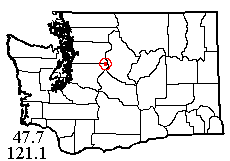 |
![]() 7 VIII 2011: Markku and his family wanted at least one more excursion, so I came up with some plans for higher elevation sites. The one we picked turned out to be a winner. Up Stevens Pass highway not quite to the pass, we turned off onto the "old highway" and then onto a Forest Service road up Martin Creek. From here, two logging roads perhaps 10 years old (not on most maps) head up the steep side of Captain Point, a mountain formerly with no road or trail access; in this instance, logging served naturalists' purposes. The road was a bit rough, but the jeep took it in stride until snow stopped us just below the 5400-foot level (the south summit is 5652 feet). The sun was just coming out, there was a light, fresh breeze, and the spider diversity at this height was like taking a time machine back to spring. Markku found a reasonable number of flowers to photograph, and we enjoyed our time here despite the mosquitos. I collected partly in the clearcut but mainly in a patch of natural subalpine parkland whose trees had been too small to log. Among others, the shrubs and trees produced rare salticid Dendryphantes nigromaculatus, two Pityohyphantes species, and Lepthyphantes mercedes. Partway back down the mountain (4500-foot level), we stopped at a remnant forest grove so I could collect from conifer litter and dead wood. I did better this time than on the previous trip, getting 8 species plus a third Pityohyphantes making webs among boulders. But as we went down, the mosquito population went up! Markku wanted a real alpine flower meadow, and so far they had been inaccessible, but I thought we could reach one up the other new logging road. Unfortunately, the meadow when reached turned out to be uncomfortably close to being vertical! And another mosquito species was becoming active. We made 2 relatively short stops down by the creek before calling it a day, keeping the jeep's windows open for some time to blow out the substantial swarm of mosquitos that had come inside while we strolled about! In a short day, I took 25 species making 30 with some old records from along the highway. Mosquitos or not, this is definitely more like it!
7 VIII 2011: Markku and his family wanted at least one more excursion, so I came up with some plans for higher elevation sites. The one we picked turned out to be a winner. Up Stevens Pass highway not quite to the pass, we turned off onto the "old highway" and then onto a Forest Service road up Martin Creek. From here, two logging roads perhaps 10 years old (not on most maps) head up the steep side of Captain Point, a mountain formerly with no road or trail access; in this instance, logging served naturalists' purposes. The road was a bit rough, but the jeep took it in stride until snow stopped us just below the 5400-foot level (the south summit is 5652 feet). The sun was just coming out, there was a light, fresh breeze, and the spider diversity at this height was like taking a time machine back to spring. Markku found a reasonable number of flowers to photograph, and we enjoyed our time here despite the mosquitos. I collected partly in the clearcut but mainly in a patch of natural subalpine parkland whose trees had been too small to log. Among others, the shrubs and trees produced rare salticid Dendryphantes nigromaculatus, two Pityohyphantes species, and Lepthyphantes mercedes. Partway back down the mountain (4500-foot level), we stopped at a remnant forest grove so I could collect from conifer litter and dead wood. I did better this time than on the previous trip, getting 8 species plus a third Pityohyphantes making webs among boulders. But as we went down, the mosquito population went up! Markku wanted a real alpine flower meadow, and so far they had been inaccessible, but I thought we could reach one up the other new logging road. Unfortunately, the meadow when reached turned out to be uncomfortably close to being vertical! And another mosquito species was becoming active. We made 2 relatively short stops down by the creek before calling it a day, keeping the jeep's windows open for some time to blow out the substantial swarm of mosquitos that had come inside while we strolled about! In a short day, I took 25 species making 30 with some old records from along the highway. Mosquitos or not, this is definitely more like it!
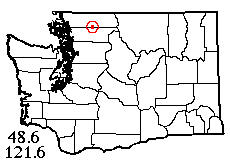 |
![]() 20 VIII 2011: With Laurel back in town for a while, I wanted to plan one last summer trip to a mountain hiking-trail destination. Of several options, we chose the Anderson Butte-Watson Lakes trail east of Baker Lake in Whatcom County. Joining us was not only Jerry Austin, but even Shannon Bowley, spider enthusiast from Renton who'd come on one of our trips last year. Moreover, at our first stop (North Lilypad Lake), who should drive up but Markku Savela, whom I'd supplied with directions in case he wanted to join us. We stopped at this little lake (3780' elevation) to sweep the marshy meadow around it, which proved a little tricky to reach, and extremely well populated with mosquitos. However, 4 species were readily swept, Shannon found a late adult wolf spider, and Jerry swept a very odd Tetragnatha by the roadside that may be a hybrid of the 2 common species. We weren't too sorry to leave this abode of dipteran vampires, and quickly reached our destination trailhead, where Shannon immediately found another good species, Zygiella dispar on the trail sign.
20 VIII 2011: With Laurel back in town for a while, I wanted to plan one last summer trip to a mountain hiking-trail destination. Of several options, we chose the Anderson Butte-Watson Lakes trail east of Baker Lake in Whatcom County. Joining us was not only Jerry Austin, but even Shannon Bowley, spider enthusiast from Renton who'd come on one of our trips last year. Moreover, at our first stop (North Lilypad Lake), who should drive up but Markku Savela, whom I'd supplied with directions in case he wanted to join us. We stopped at this little lake (3780' elevation) to sweep the marshy meadow around it, which proved a little tricky to reach, and extremely well populated with mosquitos. However, 4 species were readily swept, Shannon found a late adult wolf spider, and Jerry swept a very odd Tetragnatha by the roadside that may be a hybrid of the 2 common species. We weren't too sorry to leave this abode of dipteran vampires, and quickly reached our destination trailhead, where Shannon immediately found another good species, Zygiella dispar on the trail sign.
The trail was easy and in great condition. But as soon as we emerged into the beginnings of subalpine meadow, we were in for a shock. Instead of being full-grown with flowers, it was about 2 feet deep in snow! Well, only slightly daunted we slogged and slid onward, finding a bare area on the slope of a little ravine that seemed OK for collecting. Laurel and Shannon went about beating true firs and mountain hemlocks, adding 9 spider species in all. I swept 3 from heather and got Philodromus alascensis on the trail boardwalk. Jerry hiked over to some boulder talus on the hillside and got 5 species under stones, including rare Cybaeus #6. Laurel found P. alascensis (some in association with decidedly odd egg sacs) and Micaria constricta active on the rocks, while I traversed the snow into a snow-free old growth fir grove and sifted conifer litter for 6 species, with 2 more from dead wood. After all this, with 4 people collecting, we got 23 species in all – definitely time for end-of-summer hiatus. On the way back to the car, Laurel decided to try beating the tiny cones of mountain hemlock trees, and actually got some tiny spiders and harvestmen (all juvenile). We got back to Highway 20 just in time to take our reward for a hard day's collecting at Cascade Burgers.
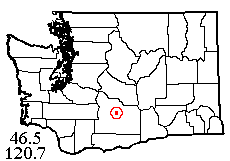 |
![]() 7 X 2011: This year's first fall collecting trip came about because Della had a yen to see the city of Yakima for the first time. Nothing loath, I planned a couple of sample-worthy areas within 10 miles of the city, and we had an uneventful drive from rainy west slope to the sunny Yakima valley. Our first and major stop for the day was a public park at the site of St. Joseph's Mission along Ahtanum Creek, the 1852 Catholic mission to the Yakima Indians. Part of the grounds are farmed, and the park part is too clean and well-groomed to have many spiders, but there was also some ungroomed riparian woodland and meadow that was very productive. I spent some time sifting the rather sparse cottonwood-willow leaf litter, not expecting much, but got 13 species supplemented by 5 from understory and 9 swept in the meadow. Wanting some insurance for a complete sample, I had a natural shrub-steppe site picked out in the same gridspace, allegedly on state land (according to the county assessor). As we went out Winchester Road, all kinds of "private" signs greeted us even though it was a public right-of-way, making Della nervous. But a young lady on horseback who talked to me after I started collecting was satisfied of my good intentions. This site added 4 more species for a day's total of 27 for about 4 hours of actual collecting. On the way home we briefly visited Della's friends the Scarletts just outside Kittitas, coming away with a rich gift of apples, pears and eggs.
7 X 2011: This year's first fall collecting trip came about because Della had a yen to see the city of Yakima for the first time. Nothing loath, I planned a couple of sample-worthy areas within 10 miles of the city, and we had an uneventful drive from rainy west slope to the sunny Yakima valley. Our first and major stop for the day was a public park at the site of St. Joseph's Mission along Ahtanum Creek, the 1852 Catholic mission to the Yakima Indians. Part of the grounds are farmed, and the park part is too clean and well-groomed to have many spiders, but there was also some ungroomed riparian woodland and meadow that was very productive. I spent some time sifting the rather sparse cottonwood-willow leaf litter, not expecting much, but got 13 species supplemented by 5 from understory and 9 swept in the meadow. Wanting some insurance for a complete sample, I had a natural shrub-steppe site picked out in the same gridspace, allegedly on state land (according to the county assessor). As we went out Winchester Road, all kinds of "private" signs greeted us even though it was a public right-of-way, making Della nervous. But a young lady on horseback who talked to me after I started collecting was satisfied of my good intentions. This site added 4 more species for a day's total of 27 for about 4 hours of actual collecting. On the way home we briefly visited Della's friends the Scarletts just outside Kittitas, coming away with a rich gift of apples, pears and eggs.
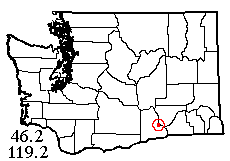 |
![]() 15-18 X 2011, The Great Klickitat Expedition: It was Laurel's idea to do one last major collecting project before finally shipping her car back to Massachusetts. We toyed with visiting three different quarters of eastern Washington, but finally decided to concentrate on Klickitat County, just north of the Oregon border, where the Ponderosa pine zone extends a long arm eastward from the mountains into the steppe zone. I assured her that cold camping would not be a problem for me. I little suspected there might be other drawbacks besides temperature...
15-18 X 2011, The Great Klickitat Expedition: It was Laurel's idea to do one last major collecting project before finally shipping her car back to Massachusetts. We toyed with visiting three different quarters of eastern Washington, but finally decided to concentrate on Klickitat County, just north of the Oregon border, where the Ponderosa pine zone extends a long arm eastward from the mountains into the steppe zone. I assured her that cold camping would not be a problem for me. I little suspected there might be other drawbacks besides temperature...
15 X: Anyway, our first stop (a bit of a detour) was to be the Richland home of Laurel's cousins. The quickest way to Richland took us over Vernita Bridge on the natural part of the Hanford Reservation. Both needing a break, we pulled into the rest area there, and beheld a nice cluster of planted Ponderosa pines in mid-desert, with cones under them! Laurel went to work cone-collecting while I got spiders from the restroom and some sagebrush and field grass that had snuck across the barrier fence. In all we got 12 species in about an hour, the best one being uncommon Salticus peckhamae from the cones.
Arrived in Richland, we found Laurel's cousins gone on a day trip, but they'd made their yard available to us for collecting. Just half a block from the Columbia River (Lake Umatilla), the place was rich in spiders including many of the usual suspects, for 8 species total. On the river side of the levee, I swept grass (added 2 species), sifted litter (added one), and looked under rocks in the riprap (added 2). Laurel collected from planted trees and buildings in a nearby park, and between us we added 13 species to a previous sample of 8, before heading for our first night's destination, Pine Springs Resort (a name irresistible to Laurel) near Satus Pass, chosen because I had 2 prior records from the pass area. The proprietress, who calls everybody "honey," directed Laurel to a small but cozy cabin and told me I could pitch my tent anywhere. The spot I picked was so stony it was very hard to get tent stakes in, but all weather predictions were for no rain whatsoever tonight. Before going to bed, I prowled around untenanted cabins to find house spiders, but only got a couple of species. I'd been in my sleeping bag a half hour (still awake due to the adjacent highway) when a light rain began. I quickly got out and tried to put the rain fly on, but couldn't do that good of a job because the stakes wouldn't go in. Then I slept until 2 AM, to awake in a pool of water – the fly had sagged, allowing a gallon plus of intensifying rain to accumulate and drip down into the tent! I spent the rest of the night in the car. Fortunately this miserable night was not a taste of things to come.
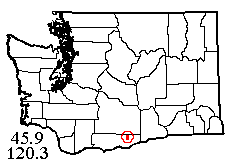 |
![]() 16 X: In the morning, all was soaked, so I couldn't collect at this site as planned, and Laurel couldn't find any open pine cones. So (after marveling at all the tame rabbits wandering about the resort), we quickly packed up and headed for Goldendale, where Laurel left me at a laundromat drying my stuff while she sampled cones at the observatory. Our chores completed, we headed out the Bickleton Highway to one of the easternmost pine groves in the county, just outside Bickleton (pop. 90). It had rained here, too, and the grass and some of the trees were still wet. I did find some dry juniper foliage to beat, got a few spiders under rocks, and finally stumbled on a hawthorn grove with some excellent litter. Laurel also had good luck from pine cones here (getting a Disembolus species new to me), but we felt we hadn't really got that many species, so we stopped nearby at the historic Cleveland Cemetery. By this time the grass had dried, but sweeping among the mostly 19th-century graves added little. I did beat 2 good ones from pine foliage, while Laurel got a further pine-cone sample. I got a nice big male Xysticus locuples from the outside of a shed, whose interior contained nothing but a huge population of late-season Polistes dominulus wasps! Our last site here was a little park by the Cleveland rodeo grounds, where I found just one spider in a very webby semi-abandoned restroom building, but beating some small firs got me the exceedingly rare Chrysso pelyx. Worth a stop for sure, even though Laurel found no good cones in the park.
16 X: In the morning, all was soaked, so I couldn't collect at this site as planned, and Laurel couldn't find any open pine cones. So (after marveling at all the tame rabbits wandering about the resort), we quickly packed up and headed for Goldendale, where Laurel left me at a laundromat drying my stuff while she sampled cones at the observatory. Our chores completed, we headed out the Bickleton Highway to one of the easternmost pine groves in the county, just outside Bickleton (pop. 90). It had rained here, too, and the grass and some of the trees were still wet. I did find some dry juniper foliage to beat, got a few spiders under rocks, and finally stumbled on a hawthorn grove with some excellent litter. Laurel also had good luck from pine cones here (getting a Disembolus species new to me), but we felt we hadn't really got that many species, so we stopped nearby at the historic Cleveland Cemetery. By this time the grass had dried, but sweeping among the mostly 19th-century graves added little. I did beat 2 good ones from pine foliage, while Laurel got a further pine-cone sample. I got a nice big male Xysticus locuples from the outside of a shed, whose interior contained nothing but a huge population of late-season Polistes dominulus wasps! Our last site here was a little park by the Cleveland rodeo grounds, where I found just one spider in a very webby semi-abandoned restroom building, but beating some small firs got me the exceedingly rare Chrysso pelyx. Worth a stop for sure, even though Laurel found no good cones in the park.
![]() My intent was to spend that night at a campground shown on the topo map at the mouth of Badger Gulch halfway back to Goldendale, near some state and TNC land parcels. The campground had no signs or facilities, but is indeed used as such, and turned out much better than my first night's camp! Bickleton Highway has so little night traffic that all was peaceful after I got a good sweep sample and did a little oak litter sifting in the last light. All ready for bed, I found it was not yet even 7 pm, so I decided to take a little walk back up the highway toward Bickleton. This took me up out of the Rock Creek canyon, to where I could see the last daylight disappear in the west, red navigation lights on distant wind turbines, and stars overhead, but (except when about 4 cars passed), not one manmade sound reached my ear! I could hear a nearby decticid and a distant coyote, that's all. A truly spirit-renewing moment, more than making up for the first night's weather failure.
My intent was to spend that night at a campground shown on the topo map at the mouth of Badger Gulch halfway back to Goldendale, near some state and TNC land parcels. The campground had no signs or facilities, but is indeed used as such, and turned out much better than my first night's camp! Bickleton Highway has so little night traffic that all was peaceful after I got a good sweep sample and did a little oak litter sifting in the last light. All ready for bed, I found it was not yet even 7 pm, so I decided to take a little walk back up the highway toward Bickleton. This took me up out of the Rock Creek canyon, to where I could see the last daylight disappear in the west, red navigation lights on distant wind turbines, and stars overhead, but (except when about 4 cars passed), not one manmade sound reached my ear! I could hear a nearby decticid and a distant coyote, that's all. A truly spirit-renewing moment, more than making up for the first night's weather failure.
17 X: In the morning, while Laurel tried the observatory pines again, dew prevented me from more sweeping but I thought, there's plenty of rocks to look under. Sure there were, with old webs, egg sacs, or retreats under the majority, but not one spider! I tried sifting oak litter, and it was very slow going. An unsuspected disadvantage of overnight collecting in the fall: in the morning cold, nothing will move! Finally, after Laurel arrived from her Goldendale motel (the Ponderosa, natch) it grew warm enough so I did get a decent sift sample. Best species from this site was Thanatus altimontis. First boneheaded moment of the trip – I left my sweep sample vial, containing 10-11 species, on the ground beside my tent, and didn't discover my error until home in Seattle! Lacking that vial, I might still barely squeak by here with 21 species, if one premolt male proves to be different when dissected.
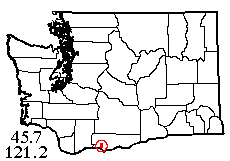 |
![]() We passed through Goldendale heading west, and took a side trip down the Klickitat River to an area where I had 14 species from years past. We collected along the Klickitat Trail, a former railroad along the river that can be hiked for 31 miles! We only had to walk about 250 meters to a fine site that had a few pines for Laurel, mixed oak and maple litter plus riparian grass for me. In only about an hour here, we got 23 species making 30 with the prior records. It was the best site of the trip for spiders, with 2 species new to the state, one of which was also a new family (Leptonetidae) for Washington's fauna! Second boneheaded moment of the trip: I casually snapped a photo of some pretty red leaves (see album), then reached through them for litter, failing to make the mental connection with poison oak (and a poison ivy plant thrown in for bad measure). As I type this it's Halloween night and I've grown my own "scare costume" on both arms (sigh).
We passed through Goldendale heading west, and took a side trip down the Klickitat River to an area where I had 14 species from years past. We collected along the Klickitat Trail, a former railroad along the river that can be hiked for 31 miles! We only had to walk about 250 meters to a fine site that had a few pines for Laurel, mixed oak and maple litter plus riparian grass for me. In only about an hour here, we got 23 species making 30 with the prior records. It was the best site of the trip for spiders, with 2 species new to the state, one of which was also a new family (Leptonetidae) for Washington's fauna! Second boneheaded moment of the trip: I casually snapped a photo of some pretty red leaves (see album), then reached through them for litter, failing to make the mental connection with poison oak (and a poison ivy plant thrown in for bad measure). As I type this it's Halloween night and I've grown my own "scare costume" on both arms (sigh).
 |
![]() We then headed upriver through the Klickitat Wildlife Area with lots of nice sites, but my top priority was the night's campsite, Outlet Creek Campground on the Glenwood Highway, a nice place operated (free) by Hancock Forest Management, which welcomes hunters (both of deer and spiders) on their land. Across the road was a biggish meadow of thankfully dry dead grass, which produced 9 species from sweeping. Farther along, I found a little grove of very young oaks among the pine trees along Outlet Creek, and took a netfull of oak-pine litter back to my picnic table to sift: only 3 species but including a possibly new Pelecopsis. Before dark, there was just time left to confirm the presence of spiders on the Douglas-firs. I got all ready for bed, too early to sleep, and decided to take another nocturnal walk. With only minimal flashlight use, I walked along the highway (with little traffic) a half-mile to explore a side road to more habitats to the north and confirm it wasn't gated. Across the highway, the road leading to an old millpond was gated but with a "hunters welcome" sign. I could see that a private logging road paralleling the highway offered good prospects for the morning. The night was not quite as silent as at Rock Creek canyon, but it was very peaceful and the stars were brighter, with Jupiter blazing like a beacon. Before retiring, I checked the camp outhouse by flashlight and got a mature Pimoa curvata.
We then headed upriver through the Klickitat Wildlife Area with lots of nice sites, but my top priority was the night's campsite, Outlet Creek Campground on the Glenwood Highway, a nice place operated (free) by Hancock Forest Management, which welcomes hunters (both of deer and spiders) on their land. Across the road was a biggish meadow of thankfully dry dead grass, which produced 9 species from sweeping. Farther along, I found a little grove of very young oaks among the pine trees along Outlet Creek, and took a netfull of oak-pine litter back to my picnic table to sift: only 3 species but including a possibly new Pelecopsis. Before dark, there was just time left to confirm the presence of spiders on the Douglas-firs. I got all ready for bed, too early to sleep, and decided to take another nocturnal walk. With only minimal flashlight use, I walked along the highway (with little traffic) a half-mile to explore a side road to more habitats to the north and confirm it wasn't gated. Across the highway, the road leading to an old millpond was gated but with a "hunters welcome" sign. I could see that a private logging road paralleling the highway offered good prospects for the morning. The night was not quite as silent as at Rock Creek canyon, but it was very peaceful and the stars were brighter, with Jupiter blazing like a beacon. Before retiring, I checked the camp outhouse by flashlight and got a mature Pimoa curvata.
18 X: In the morning, I nibbled some trail mix and headed for the little-used logging road I'd found in the dark, following it back to the millpond, which was draped with morning mist. Soon, the pine trees along the roadside were dew-free enough to beat, and yielded me 5 species. Eventually some of the firs dried enough to add 5 more. I got back to my campsite to find that Laurel had arrived and was sampling more pine cones; in all, she did 126 from this site with 6 identifiable spider species. We came away with 25 species from Outlet Creek, which is in a half-degree area with no prior good samples.
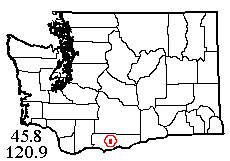 |
![]() Our last major site of the trip was a state land parcel on Blockhouse Creek, south of Blockhouse Butte, a red cinder cone that's being quarried for (what else) red cinders. This tract is clearly much used by cows, though none were present at the moment. Laurel found that the pine cones in an area rich in manure produced many more spiders than usual, of which 10 species were identifiable. I eventually found a gate in a fence that protected an unsuccessful tree-planting project, and swept a rich riparian meadow along an irrigation ditch paralleling the creek. Among the 8 species swept were the first large orbweaver taken on the trip, Argiope trifasciata, and an amazing-looking spider that I guessed must be the long-sought Larinia borealis, described from Olympia in 1894 but never seen by me until now! After a few abortive attempts (and cutting my hand on sharp marsh grass) I finally found some OK willow litter with 6 more species, and beat a couple from pine foliage. We got 22 species here in under 3 hours.
Our last major site of the trip was a state land parcel on Blockhouse Creek, south of Blockhouse Butte, a red cinder cone that's being quarried for (what else) red cinders. This tract is clearly much used by cows, though none were present at the moment. Laurel found that the pine cones in an area rich in manure produced many more spiders than usual, of which 10 species were identifiable. I eventually found a gate in a fence that protected an unsuccessful tree-planting project, and swept a rich riparian meadow along an irrigation ditch paralleling the creek. Among the 8 species swept were the first large orbweaver taken on the trip, Argiope trifasciata, and an amazing-looking spider that I guessed must be the long-sought Larinia borealis, described from Olympia in 1894 but never seen by me until now! After a few abortive attempts (and cutting my hand on sharp marsh grass) I finally found some OK willow litter with 6 more species, and beat a couple from pine foliage. We got 22 species here in under 3 hours.
After one further stop at Goldendale Observatory, we found ourselves with an hour of daylight in which we tried (without much hope) to complete unfinished business in the Satus Pass area. Not rained out this time, in fact the weather remained delightful, but there just wasn't enough time left. I did get an excellent 10-species sample from fir foliage, while Laurel got 2 more from understory, and mostly pseudoscorpions from the pine cones, near (of all things) a sewage lagoon – which was frequented by a large family of turkeys! One more visit to this area should do it. Our long drive home was completely uneventful. I didn't develop the first poison oak symptoms until later in the week. So ends another (reasonably) successful collecting expedition…
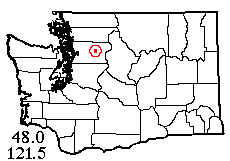 |
![]() 10 XI 2011: Finally (almost) recovered from the poison oak rash, ensuing complications, and a cold, I planned a trip with new field volunteer Joy Liu to complete some unfinished business in the Silverton area. First on the agenda after an uneventful but very scenic drive was to ascend the Deer Creek Road to the gridspace in which the August 3rd Kelcema Lake trip had produced a not-quite-there 19-species sample. We parked beside a tributary coming off Devils Peak, picked a spot and scrambled down the hillside in the seral hemlock-alder forest to an area with a few deposits of alder litter. Sifting these produced 4 species. Most of the moss on tree trunks was out of reach, but we found enough for a couple of loads of moss-sifting (6 species). Then we returned to the roadside and I showed Joy the wonders of hemlock-beating (6 species). The dew-drenched foliage never dried except in full sunlight and spider diversity seemed low, but we added 7 to the previous sample for 26 total.
10 XI 2011: Finally (almost) recovered from the poison oak rash, ensuing complications, and a cold, I planned a trip with new field volunteer Joy Liu to complete some unfinished business in the Silverton area. First on the agenda after an uneventful but very scenic drive was to ascend the Deer Creek Road to the gridspace in which the August 3rd Kelcema Lake trip had produced a not-quite-there 19-species sample. We parked beside a tributary coming off Devils Peak, picked a spot and scrambled down the hillside in the seral hemlock-alder forest to an area with a few deposits of alder litter. Sifting these produced 4 species. Most of the moss on tree trunks was out of reach, but we found enough for a couple of loads of moss-sifting (6 species). Then we returned to the roadside and I showed Joy the wonders of hemlock-beating (6 species). The dew-drenched foliage never dried except in full sunlight and spider diversity seemed low, but we added 7 to the previous sample for 26 total.
Back closer to the highway (in a gridspace with 4 prior records) along Deer Creek Road is a grassy-field parking area with an outhouse and one well-hidden picnic table. I sifted maple litter and moss (of which there was much more down here in the Stillaguamish floodplain) for 12 species, then swept a few from understory while Joy got a huge sample of perhaps 150 specimens (mostly Microlinyphia dana and Theridion sexpunctatum but with a few others) from the roadside hemlocks. Joy got a Metellina from an open gate, and I got a Pimoa from the outhouse. My hands were feeling pretty cold, but I just about concluded stoicism has its downside when Joy pointed out that my lingering poison-oak rash had turned from red to blue!
We wanted to find a different habitat for the last hour of daylight to add some more species. The large natural marsh (with boardwalk) by the Big Four picnic area just up the highway suited that purpose well. First we approached the marsh from the grassy picnic area side. We were able to wade out into it without wet feet, which should have told me something. Clearly the sun of this beautiful fall day hadnít hit this patch Ė instead of spiders, our sweep nets contained ice crystals! We retreated to the boardwalk, where the sweeping was decidedly better, and included a very good series of Pachygnatha dorothea, though all the spiders were too cold to move! Back at the parking lot, the wooden outer walls of the outhouse building produced 2 final species. My camera battery gave out just too soon to record a nice red sunset.
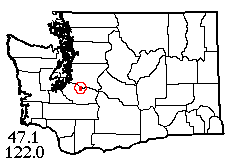 |
![]() 4 XII 2011: The day of my second trip with Joy was sunny and dry, if a bit cold (fog had been predicted). We went to lowland sites near the town of Wilkeson, central Pierce County, where I had 9 prior records, some dating back to 1970. Our first stop was the Wilkeson town cemetery – the town also owns some adjacent undeveloped land. One tract was an extremely nice stand of mature western hemlock, with salal, ferns and Oregon-grape in the understory. Understory foliage produced 9 species including colorful Walckenaeria auranticeps. Meanwhile, Joy was beating conifer foliage and did much better than her previous attempt, with 12 spider species and a harvestman. I spent a little time sweeping roadside grass (hoped-for grassland in the second part of the town tract was all taken over by blackberry), turned over a few rocks, and found 2 spiders under some discarded sheet metal.
4 XII 2011: The day of my second trip with Joy was sunny and dry, if a bit cold (fog had been predicted). We went to lowland sites near the town of Wilkeson, central Pierce County, where I had 9 prior records, some dating back to 1970. Our first stop was the Wilkeson town cemetery – the town also owns some adjacent undeveloped land. One tract was an extremely nice stand of mature western hemlock, with salal, ferns and Oregon-grape in the understory. Understory foliage produced 9 species including colorful Walckenaeria auranticeps. Meanwhile, Joy was beating conifer foliage and did much better than her previous attempt, with 12 spider species and a harvestman. I spent a little time sweeping roadside grass (hoped-for grassland in the second part of the town tract was all taken over by blackberry), turned over a few rocks, and found 2 spiders under some discarded sheet metal.
As planned, we then moved a half mile down the road to undeveloped Wilkeson Creek County Park, which includes a scenic trail along the creek ravine. The plan here was to sift litter and moss (in short supply near the cemetery). The first litter I found, in the shade, appeared to be frozen solid! In fact, we could see that much of the shady terrain on the far side of the creek was white with frost in mid-afternoon. However, a short distance upstream was a semi-sunny area at the top of the ravine with thawed maple litter. Spiders were sparse in this litter, but with much effort we pulled together a sample of 9 species. Moss on the trees was much more productive, with the same number of species from only 2 nets-full of moss. Finally, I brought home a small bagfull of the frozen cottonwood-alder litter from the ravine bottom, to see what emerged when it thawed. There were some spiders, but the only additional species was common Microneta viaria. In all, we had a very successful late fall day with 33 spider species taken, making a nice even 40 with prior records. (This time I brought along chemical hand-warmers, which worked well).
Thus ends 2011, a big collecting year. Stay tuned for 2012, coming soon!
This page last updated 21 March, 2025